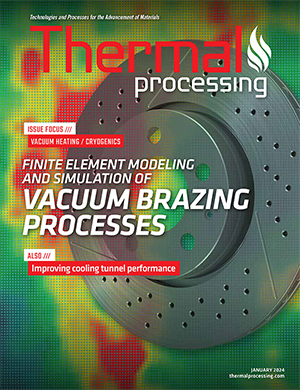
Solar Manufacturing recently received a patent (#11,815,403) for an improved vacuum furnace control thermocouple design. What makes this improved design important?
Solar Manufacturing and Solar Atmospheres are required to perform temperature uniformity surveys (TUS) with all our vacuum furnaces. When surveying vacuum furnaces with smaller diameters of approximately 36 inches or less and running at lower temperatures, the surveys were not passing as easily.
There are a few things that can be done to influence results of a TUS: For example, the insertion depth of the control thermocouple in the hot zone can be adjusted. An offset can be placed into the temperature controller (which means the controller might read 1,000°, but with a 1° offset it would actually be 999°, which is permissible per AMS, within certain limits). There are also trim controls on most furnaces to adjust power to individual heating zones that affect the overall temperature uniformity of the furnace. We came up with this design development to try to alleviate those problems, therefore making the survey less burdensome.
Can you go into more detail about why the new design was developed?
After investigating this common issue, we wanted to ascertain a way to resolve it, which was spearheaded by Bill Jones. We discovered that thermal energy was being lost by means of conduction through the thermocouple and to the cold wall of the furnace. A short control thermocouple with less length to the cold wall is an exasperating natural tendency with smaller furnaces.
Knowing it was a conduction issue, we experimented with designs that could potentially resolve the issue. We found that using a smaller diameter thermocouple helped, as there was less mass to conduct the associated heat, so less energy was being lost. At this point, we knew we were on to something, but we wanted to minimize conduction even further.
There are two ceramic tubes associated with the thermocouple. One is called an inner bore and has two holes on the inside; the other tube is on the outside, called the outer sheath. Two wires, which are dissimilar metals, run parallel to the length of the inner bore as they cannot come into contact. The temperature measurement occurs at the very end, where the two wires become connected.
For this new thermocouple, we made the inner bore a single hole and had only one of the two wires going down the tube, the other running outside the tube (still not touching the other wire), which reduced the mass. To further minimize the conduction, we then segmented that bore so it was not a constant length.
The previous design was an all-alumina ceramic, which led us to look at other ceramic materials with less thermal conductivity that also maintain good temperature shock resistance. Keeping in mind that, with heating and cooling, ceramics are susceptible to breakage if there’s too much of a temperature gradient, too quickly. This is called thermal shock. We found a good type of material that worked out very well for us.
Outside of the thermocouple design, we incorporated additional layers of insulation to the top side of the hot zone to further insulate the thermocouple.
What specific factors were affected by this improved design?
Temperature uniformity was the factor affected by this design — not to be confused with temperature non-uniformity. Although the furnace was still uniform throughout the working zone, the concern was that everything was running a little hotter (at temperatures of less than 1,200°F). This new thermocouple design basically shifts the overall temperature back down to where it should be.
Why is it critical to have that standard temperature uniformity?
Temperature uniformity is critical to ensure the outcome of any successful heat-treating process. Depending on who the customer is, the material you’re processing, and/or the specifications you are processing to, it is a requirement to have certain levels of temperature uniformity. Generally speaking, the tighter the temperature uniformity, the more process control you’re going to have, as such you are not going to have as much variability around the working zone. Typical temperature uniformity is ±10°F of the furnace setpoint; however, some requirements need to be tighter than this, and others not so stringent and can have a broader range. The level of uniformity must routinely be demonstrated and proven when running critical parts, specifically for the aerospace and medical industries.
What advantages will this new design bring to the industry as you go forward?
Our hope is that this updated thermocouple design will be used in the heat-treat industry for those who struggle with temperature uniformity results, particularly with low temperatures and smaller hot zones. Although temperature uniformity can sometimes be resolved with other “tricks,” such as the insertion depth of the thermocouple or the offset or trim controls, the goal is to have a clean TUS by avoiding any of these tricks. The biggest success with this new thermocouple design is that we are now more easily passing a TUS at lower temperatures without sacrificing results across the broad range of temperatures vacuum furnaces are capable of.
MORE INFO solarmfg.com




























